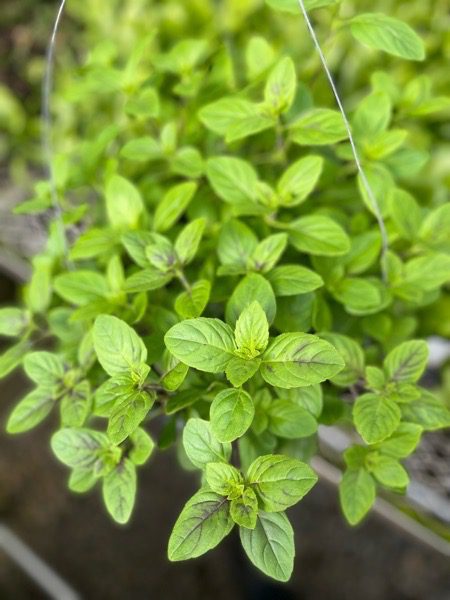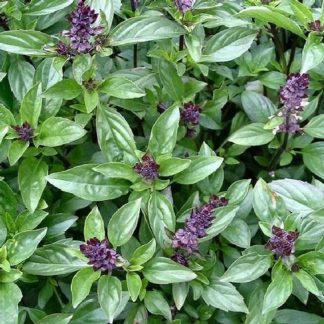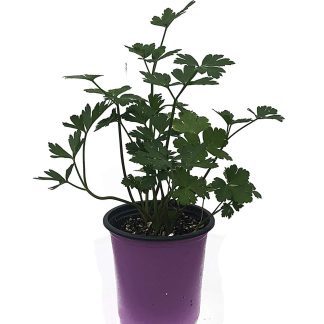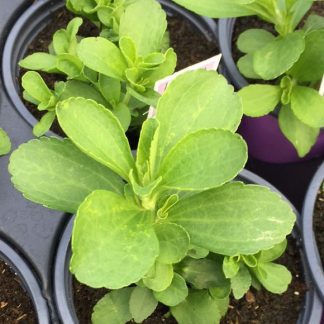Description
African Blue Basil (Ocimum basilicum x kilimandscharicum): A Beautiful and Bold Basil Variety
The African Blue Basil (Ocimum basilicum x kilimandscharicum) is unlike any other basil you have seen. It blends ornamental charm, rich aroma, and culinary potential into one hardy plant. As a hybrid of sweet basil (Ocimum basilicum) and camphor basil (Ocimum kilimandscharicum), it brings the best qualities of both parents. Its striking purple stems, green leaves edged with purple, and abundant lavender-colored flower spikes make it stand out in any garden bed or container.
This basil variety is perennial in USDA zones 9–11, where winters are mild, but it also performs beautifully as an annual in cooler climates. With proper care, it can even overwinter indoors in a sunny window or greenhouse. Its versatility makes it a favorite among gardeners, chefs, and pollinator enthusiasts alike.
Ornamental Beauty with a Purpose
African Blue Basil is not only edible but also highly ornamental. Its leaves have a unique purple flush and stay vibrant throughout the season. The plant produces tall spikes of lavender-purple flowers that bloom continuously, attracting bees, butterflies, and other beneficial insects. Unlike many other basil varieties, this hybrid does not produce seeds, which encourages nonstop flowering and makes it an exceptional choice for pollinator gardens.
Distinct Flavor and Aroma
The flavor profile of African Blue Basil is complex and slightly spicier than traditional sweet basil. You’ll notice notes of clove, camphor, and pepper, making it ideal for savory dishes, infused oils, and vinegars. It works beautifully in Mediterranean and African-inspired recipes, and the flowers themselves are also edible, adding a mild basil flavor and pop of color to salads or garnishes.
Growth Habit and Care
African Blue Basil is a vigorous grower, often reaching 3–4 feet tall and spreading 2–3 feet wide when grown in ideal conditions. Here’s how to keep it thriving:
- Sunlight: Full sun (6+ hours daily) is best for strong growth and rich leaf color.
- Soil: Prefers well-drained soil enriched with organic matter.
- Watering: Water regularly but avoid soggy conditions. Allow the top inch of soil to dry between waterings.
- Fertilizer: Feed with a balanced organic fertilizer every 4–6 weeks during the growing season.
- Pruning: Regularly pinch or cut back stems to encourage bushier growth and prolong flowering.
In cooler climates, bring potted plants indoors before frost or take cuttings to root and grow over winter.
Culinary Uses
- Pesto with a Twist: Create a richer, spicier pesto than standard sweet basil.
- Infused Vinegars and Oils: Capture its unique aroma for dressings and marinades.
- Garnishes and Salads: Use both flowers and leaves to add color and flavor.
- Herbal Teas: Blend with mint or lemon balm for a fragrant, relaxing drink.
Pollinator Magnet
One of the most remarkable qualities of African Blue Basil is its ability to attract pollinators. The abundant blossoms are highly attractive to bees, especially honeybees, which rely on nectar-rich flowers throughout the growing season. Adding this basil to your garden not only supports local pollinator populations but also boosts pollination for nearby vegetables and fruiting plants.
Container-Friendly and Versatile
African Blue Basil grows beautifully in containers, making it perfect for patios, balconies, and small gardens. Choose a large pot (at least 12 inches across) to accommodate its size and ensure good drainage. Regular pruning will help maintain a manageable shape and encourage fresh leaf growth for culinary use.
Propagation
Because it is sterile and does not produce seeds, African Blue Basil is propagated through cuttings. Simply snip a 4–6 inch stem, remove the lower leaves, and place it in water or moist potting mix. Roots usually form within two weeks, making it easy to share with friends or expand your basil collection.
Why Gardeners Love African Blue Basil
- Stunning purple-green foliage and lavender flowers
- Edible leaves and blossoms with a bold, spicy flavor
- Continuous blooms that feed bees and butterflies
- Vigorous growth and long season of interest
- Easy to propagate from cuttings
Bringing This Basil Into Your Garden
Whether you’re planting African Blue Basil for its culinary uses, its striking ornamental value, or its ability to support pollinators, this hybrid stands out as one of the most versatile and rewarding herbs you can grow. It bridges the gap between beauty and function, offering months of color, fragrance, and flavor.
A Fresh Kind of Garden Treasure
African Blue Basil adds both beauty and abundance to any space. It’s more than a kitchen herb—it’s a magnet for life, a splash of color in the garden, and a gift that keeps giving from spring through frost. Growing this basil connects us to a tradition of flavor and pollinator care, while also bringing a touch of elegance to every harvest.




